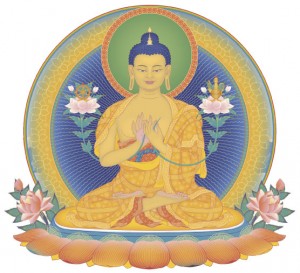Dorje Shugden and Saint George - Brothers in arms Some time ago I was attending teachings at a Dharma center. During a break I joined a group of visitors who were being shown round. One of them expressed surprise at the figure of a Tibetan Buddha who was holding a sword and riding a fierce looking Himalayan snow lion. She wanted to know why, if Buddhism was a religion of peace and gentleness, this Buddha was armed.
Dorje ShugdenThe guide explained that the Buddha was Dorje Shugden, who was the Dharma Protector of the center. A Dharma Protector has the function of spiritual guidance and protection of those who follow a particular Buddhist path. The sword was symbolic and was used to cut through the bonds of ignorance and attachment which bind us to Samsara. It was certainly not for injuring sentient beings. This explanation of the role of Dorje Shugden (also spelled Dorje Shugdan) very much reminded me of the concept of a Patron Saint in Christianity, and in particular of Saint George, who is also depicted as an armed knight. Saint George is usually shown in combat with a dragon, which he is attempting to slay using a sword, or sometimes when depicted on horseback he has a lance.
Saint GeorgeOf course the dragon also is not a sentient being. Terrestrial reptiles of that size (let alone fire-breathing ones!) have not existed during human history, so they can't be some sort of folk memory of dinosaurs - though I suppose it is possible that dinosaur fossils may have been unearthed in ancient times and given rise to legends of dragons. But, as Brian Bates points out in The Real Middle Earth [1], to ancient peoples dragons had an allegorical and symbolic significance. The typical dragon would gather and guard a hoard of treasure, and fly into fiery and destructive anger if any of the treasure were removed. And yet the dragon could not spend any of its wealth. Tolkien's Smaug in The Hobbit has many precedents in ancient folklore. So the symbol of the dragon represents the two useless and destructive delusions of attachment and anger, which Saint George is attempting to destroy. The historical Saint George was a native of Cappadocia and was martyred for his beliefs in 303 AD by the emperor Diocletian. Thus the legend of St George dates from the earliest period of Christianity, when it was still close to its Buddhist roots [2]. Saint George is the Patron Saint of several countries and cities, and is often regarded, like some of the Arthurian knights, as a symbol of Christian chivalry. As with Saint George, the historical Dorje Shugden also suffered martyrdom for speaking his mind. According to Donald Lopez Jr.[3] he was a learned and virtuous monk of the seventeenth century. He was also an expert debater, but one day his debating skills annoyed the establishment and he was found dead soon after with a ceremonial scarf stuffed down his throat. Following his death, Dorje Shudgen was adopted as the protector of the Gelug school of Tibetan Buddhism. In common with St. George, he has a chivalrous aspect, his forceful functions being to 'dispel false accusations against the innocent' and to act as the 'protector of the protectorless' [4] . So we can perhaps think of the two supramundane knights - one Buddhist, the other Christian - as brothers-in-arms in the bloodless war against delusions.
REFS [1] The Real Middle Earth by Brian Bates, published Sidgwick and Jackson 2002. ISBN 0 283 07353 5 [2] Key dates for the politically inspired removal of the Buddhist teachings from Christianity are -
[3] 'Two Sides of the same God' by Donald S. Lopez, Jr. in Tricycle, Vol VII, No 3 Spring 1998, pp 67 to 69. [4] 'Heart Jewel' by Geshe Kelsang Gyatso, second edition published Tharpa 1997 ISBN 0 948006 56 0 p.119.
The Story of Dorje Shugden - video on YouTube Part1 Part 2
The Story of Dorje Shugden - complete downloadable video (scroll down)
Dorje Shugden as protector of Nagarjuna's Middle Way
Dorje Shugden mantra OM VAJRA WIKI WITRANA SOHA
- Sean Robsville |

